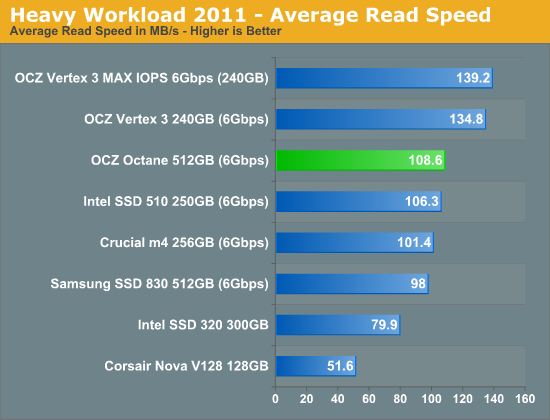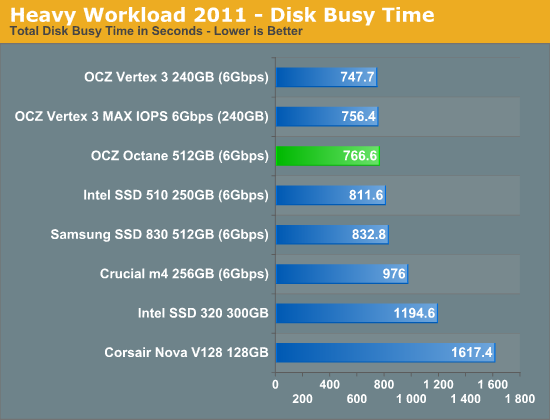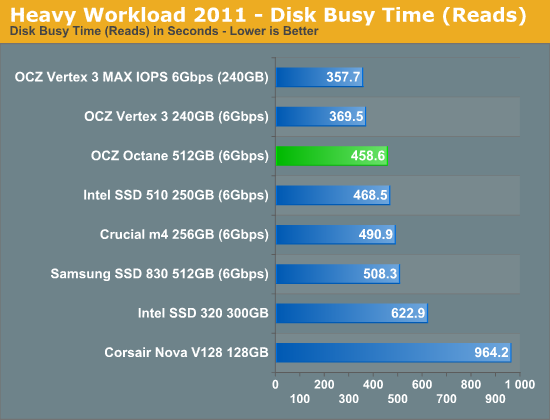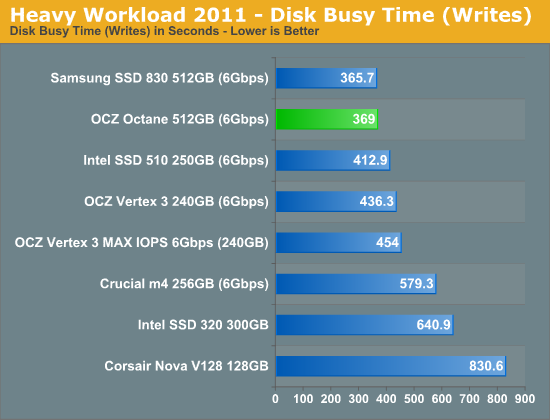The OCZ Octane Review (512GB)
by Anand Lal Shimpi on November 23, 2011 12:00 PM ESTAnandTech Storage Bench 2011
Last year we introduced our AnandTech Storage Bench, a suite of benchmarks that took traces of real OS/application usage and played them back in a repeatable manner. I assembled the traces myself out of frustration with the majority of what we have today in terms of SSD benchmarks.
Although the AnandTech Storage Bench tests did a good job of characterizing SSD performance, they weren't stressful enough. All of the tests performed less than 10GB of reads/writes and typically involved only 4GB of writes specifically. That's not even enough exceed the spare area on most SSDs. Most canned SSD benchmarks don't even come close to writing a single gigabyte of data, but that doesn't mean that simply writing 4GB is acceptable.
Originally I kept the benchmarks short enough that they wouldn't be a burden to run (~30 minutes) but long enough that they were representative of what a power user might do with their system.
Not too long ago I tweeted that I had created what I referred to as the Mother of All SSD Benchmarks (MOASB). Rather than only writing 4GB of data to the drive, this benchmark writes 106.32GB. It's the load you'd put on a drive after nearly two weeks of constant usage. And it takes a *long* time to run.
1) The MOASB, officially called AnandTech Storage Bench 2011 - Heavy Workload, mainly focuses on the times when your I/O activity is the highest. There is a lot of downloading and application installing that happens during the course of this test. My thinking was that it's during application installs, file copies, downloading and multitasking with all of this that you can really notice performance differences between drives.
2) I tried to cover as many bases as possible with the software I incorporated into this test. There's a lot of photo editing in Photoshop, HTML editing in Dreamweaver, web browsing, game playing/level loading (Starcraft II & WoW are both a part of the test) as well as general use stuff (application installing, virus scanning). I included a large amount of email downloading, document creation and editing as well. To top it all off I even use Visual Studio 2008 to build Chromium during the test.
The test has 2,168,893 read operations and 1,783,447 write operations. The IO breakdown is as follows:
| AnandTech Storage Bench 2011 - Heavy Workload IO Breakdown | ||||
| IO Size | % of Total | |||
| 4KB | 28% | |||
| 16KB | 10% | |||
| 32KB | 10% | |||
| 64KB | 4% | |||
Only 42% of all operations are sequential, the rest range from pseudo to fully random (with most falling in the pseudo-random category). Average queue depth is 4.625 IOs, with 59% of operations taking place in an IO queue of 1.
Many of you have asked for a better way to really characterize performance. Simply looking at IOPS doesn't really say much. As a result I'm going to be presenting Storage Bench 2011 data in a slightly different way. We'll have performance represented as Average MB/s, with higher numbers being better. At the same time I'll be reporting how long the SSD was busy while running this test. These disk busy graphs will show you exactly how much time was shaved off by using a faster drive vs. a slower one during the course of this test. Finally, I will also break out performance into reads, writes and combined. The reason I do this is to help balance out the fact that this test is unusually write intensive, which can often hide the benefits of a drive with good read performance.
There's also a new light workload for 2011. This is a far more reasonable, typical every day use case benchmark. Lots of web browsing, photo editing (but with a greater focus on photo consumption), video playback as well as some application installs and gaming. This test isn't nearly as write intensive as the MOASB but it's still multiple times more write intensive than what we were running last year.
As always I don't believe that these two benchmarks alone are enough to characterize the performance of a drive, but hopefully along with the rest of our tests they will help provide a better idea.
The testbed for Storage Bench 2011 has changed as well. We're now using a Sandy Bridge platform with full 6Gbps support for these tests.
AnandTech Storage Bench 2011 - Heavy Workload
We'll start out by looking at average data rate throughout our new heavy workload test:

When put to the test the Octane does not disappoint. It's within a couple MB/s of the SF-2281 based Vertex 3, and effectively one of the fastest 6Gbps drives on the market today. I included the old Indilinx Barefoot based Corsair Nova V128 to show just how far Indilinx has come here.


The next three charts just represent the same data, but in a different manner. Instead of looking at average data rate, we're looking at how long the disk was busy for during this entire test. Note that disk busy time excludes any and all idles, this is just how long the SSD was busy doing something:













75 Comments
View All Comments
Flashfir - Wednesday, November 23, 2011 - link
A little correction to your claim that OCZ is becoming jack of all trades, practically failure at all of them.Almost ALL of OCZ new lines of PSUs have been garnering really great reviews over reputable review sites like Jonnyguru and Hardwaresecrets. Personally I'm running an OCZ StealthXStream II 600w and I did my review searching, seemed good, it's running my rig excellently. 80+ Cert which actually meets bronze level!
Newest lines: ZX, Z, ZT, ZS series. I recall seeing ZS reviews, ZX reviews and ZT reviews all glowing, >9/10 ratings on Jonnyguru!
PSUs doing well, their SSD lines are suffering granted. The particular Vertex Plus line got crippled by data corruption issues when used with SATA I, instead of Sata II or III aka, lower than Sata 3GB/S standard.
They didn't loudly warn people about it nor did they loudly advertise the fix which was included in the 3.55 firmware update. I helped my roommate get one and it works great but I had to research and double check to see if all the 50%+ negative reviews on NewEgg were because of a controllable issue. It was true! And now his netbook is lightning fast.
Beenthere - Wednesday, November 23, 2011 - link
Just because of late OCZ's PSUs have improved, doesn't mean that they have resolved their QC/design issues any more than fixing one SandForce BSOD issues means SSDs are now free of reliability and compatibility issues. I just call it like it is and OCZ has and continues to have a very checkered history on product quality.Corsair has also had issues with their PSUs, SSDs and closed loop coolers. This is what happens when companies rush crap out the door for quick profits without doing proper qualification of the goods. As long as "enthusiasts" buy this half-baked crap and make these companies huge profits, that's what they will continue to deliver - crap.
Flashfir - Wednesday, November 23, 2011 - link
True. Everything you say is true. You know how emphasizing the bad without talking about anything good tends to give people the wrong ideas about how things really are.If OCZ's PSUs continue to be good from here on out, then their past is still checkered but they've spent enough effort to show they're good. Which we're seeing if they will do.
It's not about being right or wrong but whether or not if people who don't know much who read in can really get the same sense of "it as it really is". I wanted to correct you a little bit to clarify that PSU lines can possibly be improving.
Beenthere - Wednesday, November 23, 2011 - link
To be perfectly fair OCZ would not be at the top of my list for any product at the moment. Maybe five years down the road they will be selling reliable, trouble-free products, but right now I wouldn't touch their stuff. Same goes for Corsair other than their RAM. You couldn't pay me to use a half-baked Asus mobo either. All of this stuff is rushed out the door for profit before it's ready for prime time, IME.Unfortunately the PC industry is rifle with crap products - because people are naive enough to buy them.
jleach1 - Sunday, November 27, 2011 - link
Oh yeah? My stealthxstream blew in a spectacular manner 6 months after I purchased it and it filled my whole house with that burnt electronics smell that you can never seem to get out of your nose.That combined with the nonexistent support I received for a set of DDR3 dims that required lowering the speed and upping the voltages every few months has me avoiding OCZ for the 12 months Anand spoke of at all costs.
I didn't even attempt to rma my power supply.
How many people have decided just to junk their hardware after being nickeled out of a manufacturers rebate or hounded on by ocz support for months with useless questions, I don't know. And we'll probably never know.
jimbowdang - Wednesday, November 23, 2011 - link
Great review Anand, reading your comments on passing up on this drive for use on OS X makes me wonder if those hacks that supposedly allow non-Apple SSDs to use Trim actually work. I've been using an Intel G2 160 GB SSD in my 2010 13" MBP for over a year now and I've done the hack but I've never seen any testing to confirm that it actually works. I would love to see some testing on this as real Trim support would open up a lot of SSD options for OS X.NCM - Thursday, November 24, 2011 - link
Surely you'd notice if your enabling OS X TRIM on a (non-Sandforce) SSD wasn't working, at least unless you had a quite large amount of spare capacity to start with. Even then you'd eventually start reusing storage and would see a slowdown.I think it's worth making clear that although OS X only turns on TRIM by default for Apple supplied SSDs, it's trivial to enable it for third party units. It also seems reasonable to suppose that anyone motivated to install their own SSD on a Mac would also know to do that.
We're currently running four of our Macs with SSDs, two laptops and an Xserve that I ordered that way, plus a Mac Pro that I retrofitted.
Peroxyde - Wednesday, November 23, 2011 - link
Did the new CEO also setup un-honored Mail In Rebate as a business? If so it is quite successful.geddarkstorm - Wednesday, November 30, 2011 - link
Had that happen to me with two different kingston products. Don't trust mail-in-rebate to begin with, no matter who is peddling it.krazyderek - Wednesday, November 23, 2011 - link
Would have really liked to see a throughput vs transfer size for this drive :( some of us move around large compressed movies for editing and i'd like to know how the octane fairs against the m4 in such cases.also, where is the avg access time, and max latency?? could also be good points to have about a new controller!